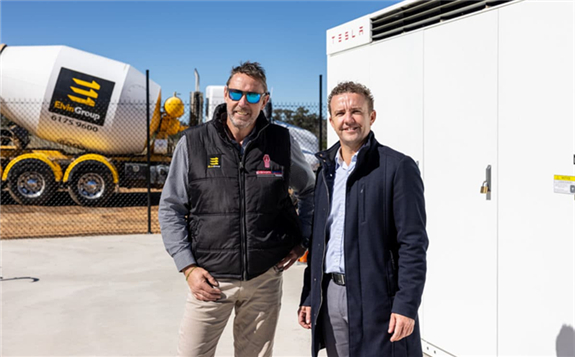In a project that has “first” written all over it, Elvin Group will next month energise its flagship energy storage project, a 2.5 MW/5 MWh front-of meter Tesla Megapack. Initially helping to regulate the flow of the Australian Capital Territory’s 100% renewable electricity supply, it will soon also stream energy from a co-located 500 kW solar array, contribute to the operation of local virtual power plants, and integrate supply from locally generated green hydrogen.

It’s the first battery installation in Australia to supplement an urban power supply at scale, and was developed in line with the needs of ACT network distributor Evoenergy.
In an exclusive preview of the project, Elvin Group Renewables Managing Director, Samuel Blackadder told pv magazine that the battery is the demonstration project and first stage in Elvin Group’s ambitious national rollout of battery energy storage systems — or rather ecosystems — that will be adaptable to regional and urban conditions and utilising the best available local renewable energy resources.
Megapack is Tesla’s advance on the Powerpacks used at Neoen’s now famously successful Hornsdale Power Reserve, which recently added 150 MW/64.5 MWh capacity to its original 100 MW/129 MWh. It is calculated to have saved South Australian consumers some $150 million and stabilised the state’s grid in extreme conditions, while proving the commercial case for batteries delivering Frequency Control Ancillary Services (FCAS) to the National Electricity Market (NEM).
This first Australian Megapack arrived, as is the formula for this system, pre-assembled and pre-tested — including battery modules, bi-directional inverters, a thermal management system, an AC main breaker and controls in the one enclosure — from Tesla’s Gigafactory in Nevada.
“We went through due diligence with other battery manufacturers in Asia,” says Blackadder, who adds, “For us, and where we see our company heading, Tesla was the best fit for technology and support.”
The full business case for Elvin Group’s unique project has yet to be revealed as the company signs agreements with market participants in the next couple of weeks.
Population growth meets grid-destabilising conditions
FCAS will play a part in commercialising the project, which was envisioned by Blackadder and members of the Elvin family around 12 months ago, in response to the threats that fire and extreme weather events posed to reliability of energy supply even as the Canberra population was known to be expanding and its energy needs increasing.
Such factors, says Blackadder, “have increased the demands on reliable power supply throughout the ACT, and networks are looking for non-network options that help avoid extended brownouts/blackouts and fluctuating voltage.”
He says the project faced several challenges in recent months, partly due to its trailblazer status, but it helped that “Evoenergy is proud to be part of innovative projects and is really looking to assist decarbonisation of the grid”.
The battery has the capacity to provide the average energy needs of about 5,400 households in the Ginninderra and Holt region of the capital’s new suburbs for an hour, and “will also stand ready to pump energy into the grid in the event of a shortfall, making sharing between the ACT and New South Wales more efficient”, the company said in a statement released today.
Hydrogen connections
Blackadder is also CEO of H2X Marine which is developing hydrogen-fuel-cell powered passenger vessels, and has trials of technology underway and in the offing, but Blackadder says the green hydrogen set to supplement the Canberra battery is separate to his endeavours in marine transportation.
Elvin Group itself is also involved in projects to develop some of Australia’s first hydrogen hubs along the east coast of New South Wales and Queensland. Blackadder says these will feature Australian developed electrolysers, which the company plans to manufacture in Canberra.
He says the point of including solar and hydrogen in Elvin Group’s first battery ecosystem is two-fold: to cater to ongoing growth in demand for clean electricity in Canberra; and to demonstrate to customers and other developers how to set up an integrated solution using batteries, although he says that despite the plug-and-play design of the Megapack, installing the battery in front of the meter triggered many extra requirements from the Australian Energy Market Operator.
Where battery systems have to stand alone
Elvin Group’s potential pipeline of similar projects, some of which Blackadder has already scoped suitable sites for, includes battery systems for, urban, regional and remote Australia.
“We’re looking at projects that are on single-wire earth return (SWER) lines and in remote parts of Australia where there is no grid infrastructure, so having multiple streams of regeneration for the battery will be critical and we envisage needing a mix of solar, wind and potentially hydrogen,” he says.